
A postage stamp is a small piece of paper issued by a post office, postal administration, or other authorized vendors to customers who pay postage. Then the stamp is affixed to the face or address-side of any item of mail—an envelope or other postal cover —which they wish to send. The item is then processed by the postal system, where a postmark or cancellation mark—in modern usage indicating date and point of origin of mailing—is applied to the stamp and its left and right sides to prevent its reuse. Next the item is delivered to its addressee.

Stamp collecting is the collecting of postage stamps and related objects. It is an area of philately, which is the study of stamps. It has been one of the world's most popular hobbies since the late nineteenth century with the rapid growth of the postal service, as a never-ending stream of new stamps was produced by countries that sought to advertise their distinctiveness through their stamps.

A cancellation is a postal marking applied on a postage stamp or postal stationery to deface the stamp and to prevent its reuse. Cancellations come in a huge variety of designs, shapes, sizes, and colors. Modern cancellations commonly include the date and post office location where the stamps were mailed, in addition to lines or bars designed to cover the stamp itself. The term "postmark" refers specifically to the part that contains the date and posting location, but the term is often used interchangeably with "cancellation" as it may serve that purpose. The portion of a cancellation that is designed to deface the stamp and does not contain writing is also called the "obliteration" or killer. Some stamps are issued pre-cancelled with a printed or stamped cancellation and do not need to have a cancellation added. Cancellations can affect the value of stamps to collectors, positively or negatively. Cancellations of some countries have been extensively studied by philatelists, and many stamp collectors and postal history collectors collect cancellations in addition to the stamps themselves.
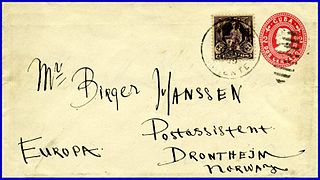
A stamped envelope or postal stationery envelope (PSE) is an envelope with a printed or embossed indicium indicating the prepayment of postage. It is a form of postal stationery.
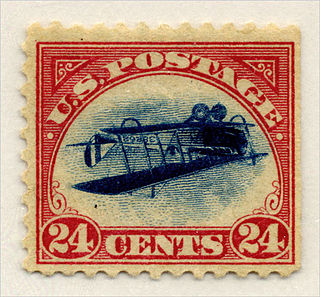
In philately, errors, freaks, and oddities (EFO) collectively refers to the wide variety of mistakes that can happen in the production of postage stamps. It encompasses everything from major design errors to stamps that are just poorly printed and includes both some of the most sought-after and expensive of all stamps and others that attract the attention of only a few specialists.

A war tax stamp is a type of postage stamp added to an envelope in addition to regular postage. It is similar to a postal tax stamp, but the revenue is used to defray the costs of a war; as with other postal taxes, its use is obligatory for some period of time.

In philately, the denomination is the "inscribed value of a stamp".
Each "article" in this category is a collection of entries about several stamp issuers, presented in alphabetical order. The entries are formulated on the micro model and so provide summary information about all known issuers.

The Mexican postal system has its roots in the Aztec system of messengers which the Spanish adopted after the Conquest. A postal service was established in 1580, mainly to communicate between the viceroyalty of New Spain with the motherland Spain. During the 18th century, Spain established a formal postal system with regular routes. In 1856, Mexico issued its first adhesive postage stamps, with "district overprints", a unique feature among postal systems worldwide, employed to protect from theft of postage stamps.

Postage stamps and postal history of the Canal Zone is a subject that covers the postal system, postage stamps used and mail sent to and from the Panama Canal Zone from 1904 up until October 1978, after the United States relinquished its authority of the Zone in compliance with the treaty it reached with Panama.

In general, philatelic fakes and forgeries are labels that look like postage stamps but have been produced to deceive or defraud. Learning to identify these can be a challenging branch of philately.

The Presidential Issue, nicknamed the Prexies by collectors, is the series of definitive postage stamps issued in the United States in 1938, featuring all 29 U.S. presidents who were in office between 1789 and 1928, from George Washington to Calvin Coolidge. The presidents appear as small profile busts printed in solid-color designs through 50¢, and then as black on white images surrounded by colored lettering and ornamentation for $1, $2, and $5 values. Additional stamps in fractional-cent denominations offer busts of Benjamin Franklin and Martha Washington, as well as an engraving of the White House. With its total of 32 stamps, this was the largest definitive series yet issued by the U. S. Post Office.

The postal history of Turkey and its predecessor state, the Ottoman Empire, dates to the 18th century when foreign countries maintained courier services through their consular offices in the Empire. Although delayed in the development of its own postal service, in 1863 the Ottoman Empire became the second independent country in Asia to issue adhesive postage stamps, and in 1875, it became a founding member of the General Postal Union, soon to become the Universal Postal Union. The Ottoman Empire became the Republic of Turkey in 1923, and in the following years, its postal service became more modernized and efficient and its postage stamps expertly designed and manufactured.

The postage stamps and postal history of Norfolk Island depended on Australia until 1947, when the island, an Australian territory since 1914, received its own stamps and postal autonomy.

In philately, an imprinted stamp is a stamp printed onto a piece of postal stationery such as a stamped envelope, postal card, letter sheet, letter card, aerogram or wrapper. The printing may be flat upon the surface of the paper, or embossed with a raised relief. An imprinted stamp is also known as unadhesive stamp or indicium.

This is a survey of the postage stamps and postal history of Gibraltar.
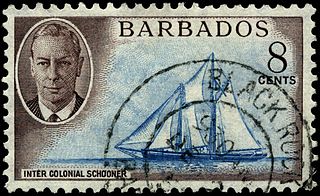
This is a survey of the postage stamps and postal history of Barbados.

The colony of the British Virgin Islands has issued its own stamps since 1866. The first Post Office was opened in Tortola in 1787. At the time postage stamps were not yet invented, and it was not until 1858 that a small supply of adhesive stamps issued by Great Britain depicting Queen Victoria were utilized by the local Post Office. These stamps were cancelled by an A13 postmark and are extremely rare so cancelled.
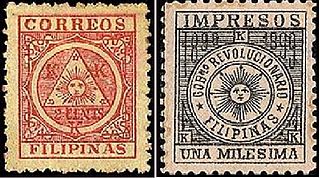
This is a survey of the postage stamps and postal history of the Philippines.
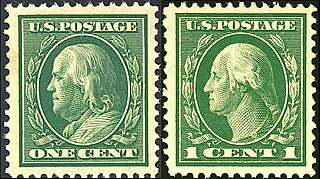
The Washington–Franklin Issues are a series of definitive U.S. Postage stamps depicting George Washington and Benjamin Franklin, issued by the U.S. Post Office between 1908 and 1922. The distinctive feature of this issue is that it employs only two engraved heads set in ovals—Washington and Franklin in full profile—and replicates one or another of these portraits on every stamp denomination in the series. This is a significant departure from previous definitive issues, which had featured pantheons of famous Americans, with each portrait-image confined to a single denomination. At the same time, this break with the recent past represented a return to origins. Washington and Franklin, after all, had appeared on the first two American stamps, issued in 1847, and during the next fifteen years, each of the eight stamp denominations available featured either Washington or Franklin.























